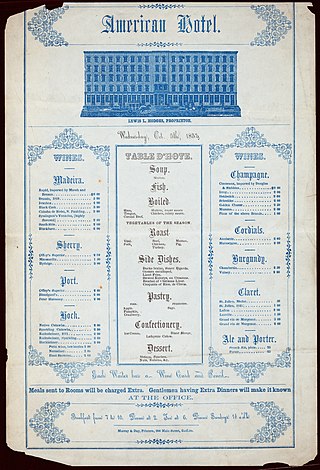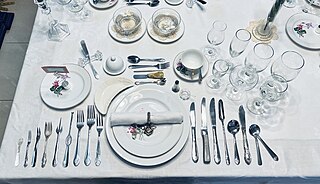Dinner usually refers to what is in many Western cultures the biggest and most formal meal of the day. Historically, the largest meal used to be eaten around midday, and called dinner. Especially among the elite, it gradually migrated to later in the day over the 16th to 19th centuries. The word has different meanings depending on culture, and may mean a meal of any size eaten at any time of day. In particular, it is still sometimes used for a meal at noon or in the early afternoon on special occasions, such as a Christmas dinner. In hot climates, the main meal is more likely to be eaten in the evening, after the temperature has fallen.
An hors d'oeuvre, appetiser or starter is a small dish served before a meal in European cuisine. Some hors d'oeuvres are served cold, others hot. Hors d'oeuvres may be served at the dinner table as a part of the meal, or they may be served before seating, such as at a reception or cocktail party. Formerly, hors d'oeuvres were also served between courses. There are two types of hors d'oeuvre from service point of view:
- General hors d'oeuvre
- Classical hors d'oeuvre

Raclette is a dish of Swiss origin, also popular in the other Alpine countries, based on heating cheese and scraping off the melted part, then typically served with boiled potatoes. Raclette cheese is historically a dish originating from the canton of Valais in Switzerland. This cheese from Valais benefits from an AOP. Raclette cheese is also a Swiss-type cheese marketed specifically to be used for this dish.

Waiting staff (BrE), waiters / waitresses, or servers (AmE) are those who work at a restaurant, a diner, or a bar and sometimes in private homes, attending to customers by supplying them with food and drink as requested. Waiting staff follow rules and guidelines determined by the manager. Waiting staff carry out many different tasks, such as taking orders, food-running, polishing dishes and silverware, helping bus tables, entertaining patrons, restocking working stations with needed supplies, and handing out the bill.

Table setting or place setting refers to the way to set a table with tableware—such as eating utensils and for serving and eating. The arrangement for a single diner is called a place setting. It is also the layout in which the utensils and ornaments are positioned. The practice of dictating the precise arrangement of tableware has varied across cultures and historical periods.

Service à la française is the practice of serving various dishes of a meal at the same time, with the diners helping themselves from the serving dishes. That contrasts to service à la russe in which dishes are brought to the table sequentially and served individually, portioned by servants.

Rodízio is an all-you-can-eat style of restaurant service in Brazilian restaurants where waiters bring a variety of grilled meats repeatedly throughout the meal, until the customer(s) signal that they have had enough.

A buffet can be either a sideboard or a system of serving meals in which food is placed in a public area where the diners serve themselves. A form of service à la française, buffets are offered at various places including hotels, restaurants, and many social events. Buffet restaurants normally offer all-you-can-eat food for a set price, but some measure prices by weight or by number of dishes. Buffets usually have some or mostly hot dishes, so the term cold buffet has been developed to describe formats lacking hot food. Hot or cold buffets usually involve dishware and utensils, but a finger buffet is an array of foods that are designed to be small and easily consumed only by hand, such as cupcakes, slices of pizza, foods on cocktail sticks, etc.

Various customary etiquette practices exist regarding the placement and use of eating utensils in social settings. These practices vary from culture to culture. Fork etiquette, for example, differs in Europe, the United States, and Southeast Asia, and continues to change. In East Asian cultures, a variety of etiquette practices govern the use of chopsticks.

Tableware items are the dishware and utensils used for setting a table, serving food, and dining. The term includes cutlery, glassware, serving dishes, serving utensils, and other items used for practical as well as decorative purposes. The quality, nature, variety and number of objects varies according to culture, religion, number of diners, cuisine and occasion. For example, Middle Eastern, Indian or Polynesian food culture and cuisine sometimes limits tableware to serving dishes, using bread or leaves as individual plates, and not infrequently without use of cutlery. Special occasions are usually reflected in higher quality tableware.

A tureen is a serving dish for foods such as soups or stews, often shaped as a broad, deep, oval vessel with fixed handles and a low domed cover with a knob or handle. Over the centuries, tureens have appeared in many different forms: round, rectangular, or made into fanciful shapes such as animals or wildfowl. Tureens may be ceramic—either the glazed earthenware called faience, or porcelain—or silver, and customarily they stand on an undertray or platter made en suite.

In restaurant terminology, a table d'hôte menu is a menu where multi-course meals with only a few choices are charged at a fixed total price. Such a menu may be called prix fixe. The terms set meal and set menu are also used.

A full-course dinner is a meal with multiple courses, almost invariably eaten in the evening or afternoon. Most Western-world multicourse meals follow a standard sequence, influenced by traditional French haute cuisine. It commonly begins with an appetizer, followed by the main course, the salad course, and eventually the dessert, but the exact sequence varies widely. Full-course dinners are generally very formal as well as very expensive, and can have as few as 3 or as many as 21 courses. Some major styles include service à la russe and service à la française.

Charger plates or service plates are large plates used at full-course dinners and/or to dress up special events like parties and weddings. Charger plates have been in use since the 19th century.

Table manners are the rules of etiquette used while eating, which may also include the use of utensils. Different cultures observe different rules for table manners. Each family or group sets its own standards for how strictly these rules are to be followed.

Finger foods are small, individual portions of food that are eaten out of hand. They are often served at social events. The ideal finger food usually does not create any mess, but this criterion is often overlooked in order to include foods like tacos. One origin for finger foods is the French canapé.
The historical form of service à la russe is a manner of dining with courses brought to the table sequentially, and the food portioned on individual plates by the waiter. It contrasts with the older service à la française, based on several courses brought to the table simultaneously, in an impressive display of tureens and serving dishes, with diners plating food themselves.
Restaurants fall into several industry classifications, based upon menu style, preparation methods and pricing, as well as the means by which the food is served to the customer. This article mainly describes the situation in the US, while categorisation differs widely around the world.
In the restaurant industry, gueridon service or tableside service is the cooking or finishing of foods by a waiter at the diner's table, typically from a special serving cart called a guéridon trolley. This type of service is implemented in fine dining restaurants where the average spending power is higher, and an a la carte menu is offered. Gueridon service offers a higher style of service to the guest.

Customs and etiquette in Chinese dining are the traditional behaviors observed while eating in Greater China. Traditional Han customs have spread throughout East Asia to varying degrees, with some regions sharing a few aspects of formal dining, which has ranged from guest seating to paying the bill.














